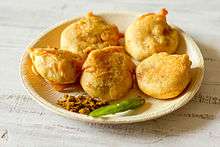Batata vada
|
| |
| Course | Hors d'oeuvre / Starter / Appetizer |
|---|---|
| Place of origin | India |
| Region or state | Maharashtra |
| Main ingredients | Potatoes |
|
| |

Batata Vada (Marathi: बटाटा वडा) is a popular Indian vegetarian fast food in Maharashtra, India. It literally means potato fritters. The name "Batata" means potato in Portuguese who introduced potatoes in India. It consists of a potato mash patty coated with chick pea flour, then deep-fried and served hot with chutney. The vada is a thick sphere, around two or three inches in diameter.
Although Maharashtrian in origin, Batata Vada is gaining popularity in the rest of India as well.[1]
Preparation
The potato filling and the batter used to coat the filling are the only two components of batata vada.
The potatoes are boiled, mashed coarsely and kept aside. Vegetable oil is heated in a pan and ingredients like asafoetida, mustard seeds, chillies, onions, curry leaves are added and fried for a couple of minutes until the onions are translucent. Ginger-garlic paste, turmeric and salt are then added and fried for a few seconds, after which the mashed potatoes are added to the mixture and cooked for a few more minutes.
A thick batter is made using chick pea flour, seasoned with salt, turmeric and red chilli powder. Sometimes a small quantity of baking soda is also added to make the batter fluffier. To make the fritters, little balls of the potato mixture are coated in the batter and deep-fried in a couple of inches of hot vegetable oil.
Serving
Batata vada is typically served very hot with green chillies and chutneys of various types. The most common way to eat it though is in form of Vada pav.[2]
Gujarati people eat Bataka Vada with Gujarati style Fruit Salad.